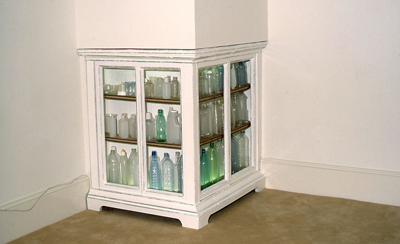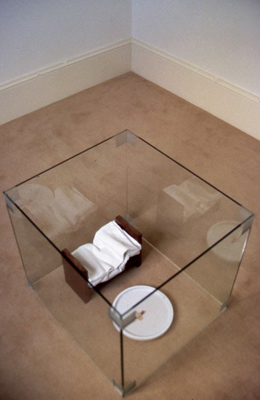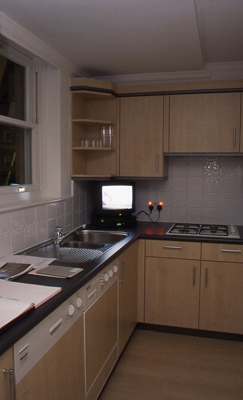Works Perfectly
Behind A Painted Door – Lynn MacRitchie
Rear Window Publications
1994 © Lynn MacRicthie
A quiet street in central London, a creamy Regency façade…
What lies behind it?
A simple question, but not, as we will discover, one that can be easily answered.
“A brand new London terrace comprising 84 superb apartments with 95 underground parking spaces, finished to an exemplary standard and offering a level of convenience and luxury designed to meet the exacting demands of the modern market,” says the glossy brochure from Savills, Selling Agents. They are the gatekeepers of this strange hybrid, controlling our access into the elegant shell o Thomas Cubitt’s 1835 terrace. They are anxious to be helpful. A video informs us of the flats’ comfort and convenience, their prime location. A show flat demonstrates how they might be furnished in tasteful, Georgianish-ish style: bathrooms and kitchens are already fitted and equipped, carpets laid. What are we waiting for?
It is a tight squeeze in the stairwell. Steps wind up and up, to realms once thought fit only for servants, tucked away under the eaves. The smell of carpet catches the throat in the confined space. A brass furnished door swings open. Apartment type H, floor area 944sq. ft, is on two levels, with two bathrooms, kitchens, living room, three bedrooms… All the listed features are in place, but all is not as it seemed in the pictures. Where are the umbrella stands and parallel couches, the varnished bread and bathroom pot-pourri? What has happened to those careful furniture arrangements which made so much of the “available entertaining space” and strove to suggest that a couple, their friends, even their children could occupy this tiny dwelling in perfect happiness? Inside this apartment, the silence of taste has been shattered. This interior will not shut up. It cries and groans, its objects offer themselves not as the polished accoutrements of a dream world but as the articulators of questions, which, even if they can never be answered, demand to be heard.
Ignore for a moment the sound of smashing crockery which seems to be coming from the kitchen and a more muffled, obscure noise from upstairs, and steps into the Reception Room, picking your way past an object occupying prime floor space. What is it, this elegant but not immediately recognisable shape? It appears to be a case, but a case for what? Its grammar—stitched leatherette covering, chrome metal clips, bulbous form—is that of the musical instrument case, but its shape is unique. Its maker, Hadrian Pigott, calls it an instrument of hygiene. Undoing the clips left invitingly open reveals a rich red velvet interior and a nestling hand basin, waste pipe and soap included, ready to make a performance of washing. In the downstairs bathroom immediately opposite the front door, Pigott has provided a row of six toilet rolls mounted on a faux marble slab, their pastel colours—mauve, pale yellow, pale pink, white, pale green, orange—carefully graded, their redundant diversity a demonstration of Choice.
On the Reception Room wall, Alan Curry’s Monitor seems to offer the comfort of the functional. These chipboard blocks, these melamine finishes must surely serve some purpose? But something has gone wrong. The logic of the kitchen unit has been disrupted, its promise of order remains unfulfilled. Nothing can be stored or disposed of in these seeming practical receptacles, nothing placed on these wipe down surfaces, studded with questioning holes. The narrative of construction has been misplaced, both as practical storage space and as minimal art. Curry enjoys playing against formal languages and concepts such as truth to materials by engaging in perverse practices such as carving chipboard. “The erasure of the self is not possible… the self remains the virus in the system.”* The ordered, cramped space of the show flat, with its predicated behaviours and expectations may lead to confrontation and antagonism, because no space is offered to exhibit the self. “The suppression present in these walls indicates an acceptance of certain types of control,” Curry observed, pointing out that the development of modernism, the root of “functional” design, included an oppositional position in relation to the established order. Now, however, the language of modernism too has been fractured. “Sculptures,” no matter how minimal, “are empty without selves behind them…”
In an awkward corner where the ceiling takes an alarming swoop down towards the floor, Neil Cummings has fitted a specially made cupboard, shelved and interior lit, in which a collection of used plastic bottles is displayed. Noting the choice of a pseudo Georgian style of interior décor in the entrance way and show flat, “trying to make some sort of Georgian flat towards the end of the twentieth century, using building techniques from high volume council housing,” Cummings made the cupboard to mimic Georgian furniture, but using cardboard. “Only the shape gives it authority… the context that you find things in gives them a meaning.” Cummings believes “it is impossible to make a dumb sign,” and works with a complicated layering of references set up to establish a particular range of relationships, in this case, “inserting something in the show flat which is extremely domestic but which shows a display of things you would otherwise ignore,” old plastic bottles which have all passed through Cummings’ own house. Although arguing that the “faith” which allowed people to make abstract sculpture is gone, Cummings believes that bringing things which are otherwise ignored into specific relationships, however temporary, paying careful attention to examples plucked from the great sea of things which characterises late twentieth century consumer culture, can be of value. “Objects from the world of use might offer some hope for us, helping us to consider how we live.”
Back through the entrance hall, a handsome chair sitting by the open plan kitchen seems emblematic of traditional values—a carver’s chair, used by the master of the house when he sits at the head of the table presiding over Sunday lunch, Sunday lunch in an open plan kitchen, a kitchen filled with the sound o shattering china… The master’s chair is made of wood, solid and dependable, its arms spread out to accommodate the user, an embroidered seat cover adding a touch of colour, its complex pattern not immediately readably. Images of male genitalia, for that is what the pattern is, are “so hidden we do not recognise them,” Rebecca Scott believes. If they are seen, it tends to be I the context of pornography, rising erect from their often bemused looking hosts, who can seem almost perplexed at their own virility. Scott’s large paintings of make nudes based on pornographic playing cards, were described as “disgusting” by several male viewers, who declared that they did not know how she could have borne to look at, far less recreate, such images. By rendering them through knitting, she describes herself as striving to soften the phallic imagine, make it part of a female vocabulary of visual pleasure. She also enjoys the humour of bringing together the notion of the “old spinster sitting at home knitting squares for Oxfam” working penis patterns as she daydreams over her needles. Upstairs, matching cushions are scattered in the eponymous master bedroom.
But what of the master’s bed? Graham Plumb’s Airbed lies naked on the floor, its clear plastic pierced by drain fittings which both articulates and threaten its form, defined only by air. If the pump stops, the bed collapses, as its constant sound, like the rhythm of breathing, suggests. There is little comfort to be found in this bed, its centrality to the cycle of birth and death undermined by the fragility of its construction. Like the master, it can crumple at any moment… Plumb enjoys playing with formal devices such as grids to alter the presence of familiar objects, where instead of increasing a feeling of stability, they may do the opposite, creating unease, a feeling of threat. The viewer, compelled to listen to the “breathing bed” feels the breath in their own lungs, the catch in the throat.
In the en-suite bathroom, Hadrian Pigott has thoughtfully provided 18 cakes of soap each inscribed with the name of a part of the body in the order of its washing. Stretched out in the bath, he would begin with the feet. “Under siege, I take refuge in the bathroom,” there to ponder the contradictions of cleanliness and the foul materials—animal fat and caustic soda—with which it is achieved. Like the dubious comfort of the mattress outside, the bath itself, which promises the resurrection of cleansing, offers no lasting peace. “Western notions of hygiene are fatally flawed—we flush things ‘away,’ but there is no ‘away’…”
In the second bedroom, a strange tableau awaits. Jacqueline Pennell likes to work with difficult spaces, “the naff rooms nobody wants,” investigating them to discover the secrets of the discomfort they inspire. The installations and objects which result are often disturbing, drawing the viewer into a state of psychological unease and provoking unexpected emotions such as sadness or fear, opening old wounds. In the show flat, she felt constrained by the smallness of the room and the requirement to keep its surfaces clean and untouched. Her solution was to construct “a little glass box like an incubator.” Within its glass walls, everything the room might hold has been concentrated in miniature. A tiny bed is covered by a full size sheet folded over and over. Over the bed hands a clock, its hand taped together, the second hand still twitching. The cable from a single light bulb inside the box is the only connection between the room and the room within the room. The sheets of glass are held together with sticking plaster. “Their wounds are holding them up,” says Pennell, in whose glacial incubator nothing grows, only decay.
There is one more bedroom. It is tinier still. It is empty save from a toy pig and a nightlight. From the big, a strange sound emerges, a combination of animal grunting and human female sounds, sexual sounds. Alexandra McGlynn is interested in exploring the mediation of sexuality and the suppression of sexuality in the family. Perhaps the man of the house might visit a prostitute, bringing the traces of her street based, night-time trade into the enclosed world of the home, where the children lie in tiny rooms with a nightlight for comfort. McGlynn takes photographs, shooting night-time street scenes in natural light, intrigued by the shift between daytime mundanity and the mysterious possibilities of the night. She has played recordings of prostitutes touting for business through hidden speakers in a “respectable” street and, hidden, spied on the results. Here she brings the cadence spreading from public to private space. Their rhythm is counter-pointed by the sound of china smashing.
Back down in the kitchen, a video is playing. In Leave them, I’ll do them later, by Orla Ryan, mugs of coffee are smashed against a white kitchen wall, the dark liquid running down the one clean surface, the broken china piling up on the brown work-surface. Sound and vision are slowed down. The tape repeats, every two minutes, in an endless litany of mundane destruction, an expression of everyday rage.
Since the beginning of this century, the world has ceased to be a place where appearances could be taken for granted. In Europe, Picasso and Braque invented Cubism and the way we saw changed. Duchamp signed the urinal and the meaning of objects shifted. Freud smoked his pipe and listened as the dark secrets of family life tumbled out of their silence. The use of aerial bombardment made the home a target, for both sides, in the Second World War.
When systems are challenged, equilibrium is broken. Once shifted, foundations cannot be set back. One question asked suggests another, one revelation creates the need for the next. The process of inquiry seems unstoppable, and security of all kinds, personal and political, begins to fragment.
The home itself has been destabilised, first by bombs, and in the immediate past decade, by a shifting of social values engineered by government which transformed it from a place of permanence to one of transience, its value fixed not in stability but in exchange. Its occupants, those families who were told their “values” were the bedrock of social organisation, have had them sorely tried by job losses and benefit cuts. Individuals have been set adrift, and abuse and neglect have replaced self-sacrifice and care. Walls have crumbled, and nothing is sacred.
Young artists, the clear-eyed children of such cruel times, have learned their lesson. What you see may not be quite what you get, what you hear may be designed to deceive. There is no longer any such place as safe ground.
* All quotations are from conversations with the artists.





